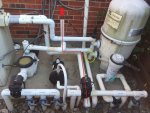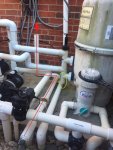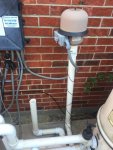I was hoping to get a little advice on the backwash plumbing for our pool. I'm new to all of this - we just bought a house with our first pool, so sorry if this is a very basic question. The pool inspector told us that our backwash valve was never plumbed completely. Below is the backwash valve waste outlet (I think) in green, and another line in red that I'll explain below. I've included two pictures so you can see the plumbing from two different angles.


1. The piped line in red is not connected to anything at the top (by the red arrow) and appears to simply run to the edge of the pad and discharge there (with a spigot on the end for some reason - is that normal?). Should this be the discharge line for the backwash valve? Is there any other purpose this line could or should serve?
2. Is there anything wrong with leaving the waste outlet for the discharge valve (in the green circle) open as it currently is? In this setup, it would just dump out onto the concrete pad by the filter. I don't plan to do this but am just wondering if there was anything wrong with what the previous owner was doing that may have caused any problems. Also wondering if this is something that should absolutely be addressed before we start the pool back up (it's getting new plaster, coping, and tile right now).
3. Would you suggest plumbing the valve outlet (the green circle) to the other line that appears to be connected to nothing (the red line)? Or should I do something else to pipe the backwash outlet discharge out away from the filter?
Thanks for any thoughts or help!


1. The piped line in red is not connected to anything at the top (by the red arrow) and appears to simply run to the edge of the pad and discharge there (with a spigot on the end for some reason - is that normal?). Should this be the discharge line for the backwash valve? Is there any other purpose this line could or should serve?
2. Is there anything wrong with leaving the waste outlet for the discharge valve (in the green circle) open as it currently is? In this setup, it would just dump out onto the concrete pad by the filter. I don't plan to do this but am just wondering if there was anything wrong with what the previous owner was doing that may have caused any problems. Also wondering if this is something that should absolutely be addressed before we start the pool back up (it's getting new plaster, coping, and tile right now).
3. Would you suggest plumbing the valve outlet (the green circle) to the other line that appears to be connected to nothing (the red line)? Or should I do something else to pipe the backwash outlet discharge out away from the filter?
Thanks for any thoughts or help!



